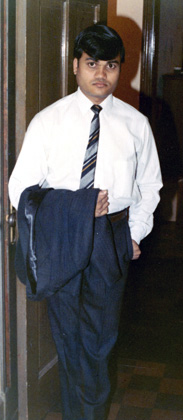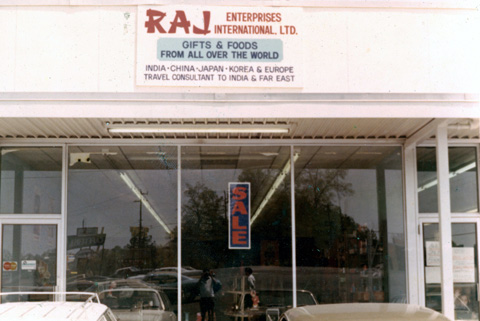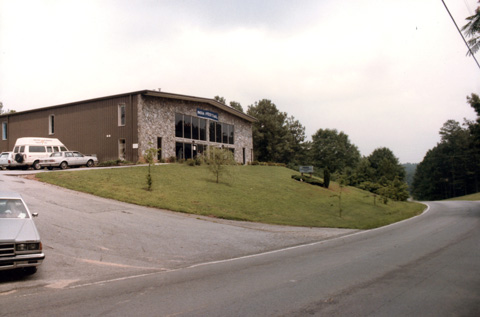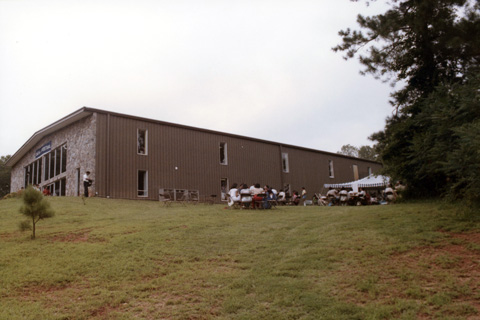From 1 to 100,000: The Pioneers, Pillars, and Milestones of the Atlanta Indian Community

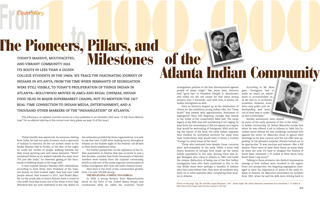
Today’s massive, multifaceted, and vibrant community has its roots in less than a dozen college students in the 1960s. We trace the fascinating journey of Indians in Atlanta, from the time when remnants of segregation were still visible, to today’s proliferation of things Indian in Atlanta—Bollywood movies in AMCs and Regal Cinemas, Indian food isles in major supermarket chains, not to mention the 24/7 real-time connection to Indian media, entertainment, and a thousand other markers of the “Indianization” of Atlanta.
[The following is an updated, rewritten version of a story published in our December 2002 issue: “A Trip Down Memory Lane.” For an editorial referring to this current cover story, please see page 10 of this issue.]
Vishal Gandhi was awestruck. As someone visiting from India, he had not quite foreseen such a spectacle of Indians in America. As the car inched closer to the Sardar Bhavan Hall in Tucker, in the dim of the night, he could see hordes of people walking towards the Hall, many sporting saris and salwar kameezes. “Wow!” exclaimed Vishal as he walked towards the main door. “It’s just like India,” he observed gazing at the thousands of bobbing heads in the huge Hall.
It was Gujarati Samaj’s Navratri 2002 celebrations. According to Amit Shah, then President of the Gujarati Samaj, on their busiest night, they had over 5,000 people attend. Fast forward to 2017, and Shakti Mandir, on the south side of metro Atlanta drew a crowd of over 8,000. And that is just one of the three or four “big” Navratris that are now celebrated in the city. Based on the estimates provided by these organizations, it is safe to say that over 12,000 were making merry throughout Atlanta on the busiest night of the festival—all decked in their finest traditional wear.
For further perspective on the explosion of the Indian population in Atlanta that has occurred in just a few decades, consider that these thousands of Navratri revellers were mainly from the Gujarati community, which is only one of the many regional communities of Indian immigrants who now call metro Atlanta home.
Here then is the story of the community’s growth, from 1 to over 100,000 strong...
THE BEGINNING: COMING TO GEORGIA
In 1958, a young Senator from Massachusetts
stood on the Floor of the United States Senate and
condemned what he called his country’s “racist
immigration policies of old that discriminated against
people of Asian origin.” Two years later, America
said “good bye” to President Dwight D. Eisenhower
and rolled out the red carpet for that same young
senator, John F. Kennedy—and with him, it seems, for
Indian immigrants as well.
Even as America shaped up as the destination of choice for the ambitious young Indian elite, the “Deep South” was viewed with apprehension. Remnants of segregation were still lingering. Georgia was smack in the midst of the conservative Bible Belt. The racist legacy of the KKK was still smoldering if not raging. At least from the stereotypes, it did not appear as a region that would be welcoming of foreigners. With such being the repute of the land, the early Indian migrants here treaded on uncharted territory. Far away from their motherland, they would have to brave a country “foreign” in every sense of the word.
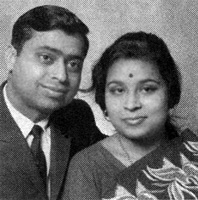
(Left) Mr. and Mrs. Jagan Bhargave, 1967.
Those who ventured here despite those concerns were well-rewarded. In the early 1960s, a mere half dozen students at Georgia Tech made up the entire Indian population in the area. Among them was Jagan Bhargave who came to Atlanta in 1962, and holds the unique distinction of being one of the first Indian immigrants here who have continued to live in the city. While there were perhaps a handful of Indians who had come before him, they were all students who went on to other pastures after completing their studies in Atlanta.
According to Mr. Bhargave, “Georgians had to make as much an adjustment to accommodate us, as we had to, to acclimate ourselves. However, most were very polite and understanding and went out of their way to make us feel comfortable.”
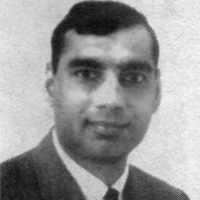
(Left)Mr. Sohan Manocha remembers how Interstate 1-75 ended at West Paces Ferry Road, when he first moved to the city!
Similar sentiments were shared by some of the early pioneers of the Atlanta Indian community. Dr. Sohan Manocha recalls that when he was offered a job in Atlanta in 1964, his Canadian peers (where he was studying) cautioned him against the move. Dr. Manocha chose to ignore their warnings as he was curious, and the job offer was appealing. To his pleasant surprise, Atlanta turned out to be spectacular. “It was luscious and serene—like a hill station. There were at least three times as many trees as there are now. It’s hard to imagine the Atlanta of those days. Interstate 1-75 ended at West Paces Ferry Road! Need I say more?”
Talking to these pioneers, two distinct impressions emerge of how Indians were received in the region. From one perspective, the lingering segregation managed to taint the experience of some of the early Indians in Atlanta. Dr. Manocha remembers an incident from 1965, when he and his wife were driving back to Georgia from New Orleans, and they had to make a restroom stop. “I was handed the key for the ‘colored’ bathroom,” he now recalls with amusement, even though at the time, he said, it was humiliating. Growing up in India with an image of America as a progressive and scientifically dynamic country, he remembers being quite shocked at this regressive aspect of segregation in his new homeland.
Dr. Manocha’s wife, Mrs. Swaran Manocha, who had a Master’s degree, had been interviewing for a teacher’s position and was being repeatedly rejected even in schools that had a definite need. When confronted, one interviewer even ventured to say that he wouldn’t hire her because she would be bringing ‘foreign influence’ into the school.
Similarly, there were incidents in the ’60s where dark skinned Indians were denied service in restaurants.
Raj Shah, who came to Atlanta in 1967 says, “The Vietnam war was winding down, and the country was in recession, and hence the job market was not favorable for Indian immigrants. There was a subtle prejudice against brown skin foreigners, which was more prevalent in the South than the North. Discrimination was also an issue in getting apartments in certain neighborhoods. An Indian accent during a phone inquiry for apartments would often result in a response of ‘no vacancy.’”
On the other, more pervasive side, most early Indians had nothing but high praise for how warmly they were welcomed and embraced by their coworkers and neighbors in their new land. It appears Southern hospitality had won over Deep South attitudes when it came to the initial assimilation experiences of Indians.
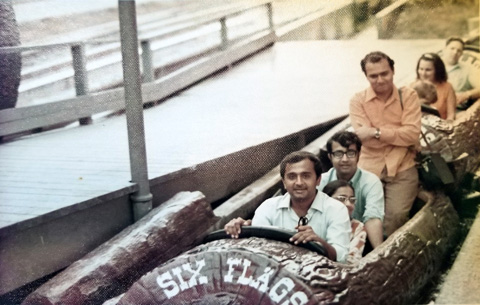
Niranjan Sampat (3rd from front) at Six Flags over Georgia, late ‘60s. On the front is Kirit Gandhi, another pioneer of Atlanta.
Niranjan Sampat, who came to Atlanta in 1967 to pursue an MBA degree, said that he never directly experienced any discrimination or bigotry. As a college student he had an American host family that would invite him for dinner at Thanksgiving, Christmas, and other occasions. “They were very gracious and made me feel like I was part of the family.” It was the same at his work: “I always felt that my professional progress was smoother and faster than my peers, right from the early days.”
Most of the pioneers we interviewed pointed out that the first wave of immigrants were primarily professionals— scientists and engineers, many of whom were working on their postgraduate and even doctorate degrees. This, according to them, was the reason for the high regard in which Indians were held among locals.
THE RIGORS OF PIONEERING
The welcome they received didn’t make their transition
and assimilation any less daunting. “East is East,
and West is West, and never the twain shall meet,” so
prophesied Rudyard Kipling over a century ago. Now
these pioneers were set to prove Kipling wrong by
merging their Eastern ways into their new Western
lives.
The challenges were many. To begin with, they had to contend with a whole new diet that was foundationally different, not to mention religiously out-of-bounds for many of the avowed vegetarians. Growing up in the land of chai and rich spices, one can only imagine the discord to the Indian palate that the typical local fare of steak, sweet corn bread, and mashed potatoes would inflict.
“Vegetarianism was seen as totally strange. On top of that, the bland food was very hard to relish. There was nothing available for the Indian taste buds,” observed Mr. Bhargave. “In the ‘60s, even a Mexican restaurant was out of the question. Chinese was the only ethnic food you could find,” he added.
The lack of traditional Indian produce and spices compelled the young new migrants to be creative—such as using yellow split peas to make daal, and Bisquick to make gulab jamuns.
The old-timers would well heed us to drop to our knees and thank our lucky stars that today we have an Indian grocery store in just about every suburb of Atlanta. There was a time when there were none—and the early Indians propelled by the power of their palates ordered Indian groceries by mail... all the way from New York. Mrs. Girija Vijay who came to Atlanta with husband Dr. K. K. Vijay in 1965, recalls that a bunch of Indians would join together to order a shipment of groceries from Pathak Condiments in London, England. “And the sarees would have to be ordered from Harilela of Hong Kong!!” she added.
|
|
Raj Enterprises, Atlanta’s first Indian
grocery store, started in 1972. |
It was 1972 when Atlanta first saw its very own Indian grocery store. Raj Enterprises, started by Raj Shah, with an inventory of $3000, was located in an old office building in midtown Atlanta. It was a godsend for the still nascent community. “It was like going to the temple! The fragrance of achaar was tantalizing,” recalls Dr. Manocha.
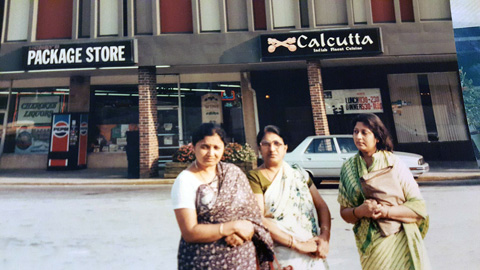
(Left) Calcutta, Atlanta’s first Indian restaurant, started in 1973 by the late Bhattacharyas, Ashok and Sumitra. Sumitra is pictured on the far right.(Photo: courtesy Aparna Bhattacharya)
Similarly many remember fondly the Calcutta Restaurant that started in 1973, as the first Indian restaurant in Atlanta.
Besides the everyday food issue, challenges of assimilation abounded in just about all spheres of life. Steep learning curves, culture clash, accent, and communication hurdles all posed problems.
To begin with, the disparity in technology and modern conveniences between India and the U.S. was huge in those days. An Indian immigrant coming today is very much at home here, now that the world has turned into a ‘global village.’ Back then, even rudimentary things such as an escalator and revolving doors were “firsts” for Indians. Not stepping in two-at-a-time into a revolving door may seem like common sense, but to a newly arrived Indian who, to begin with, was inundated with sensory overload of all kinds, and who was used to crowding in local buses and trains back home, such presence of mind would be expecting much.
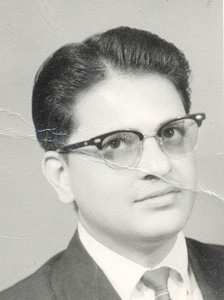
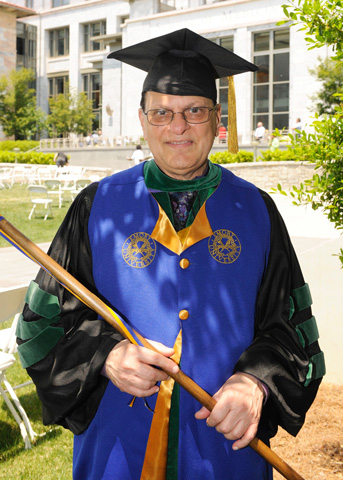
Dr. Bhagirath Majmudar, then (1965); and now, just prior to his recent retirement after a distinguished career in medicine at Emory University and Grady Hospital.
Many such embarrassing predicaments came about, not because of lack of any native intellect or common sense, but simply because things were new and different. Dr. Bhagirath Majmudar, a veteran of the community, recounted a humorous story that was making the rounds in those days. An Indian ordered tea at a fast food restaurant and was handed hot water along with the tea bag and a couple of packs of sugar. After some contemplation, he tore open the tea bag and proceeded to pour it into the hot water. Observing this, the kind attendant mentioned that actually the whole tea bag needed to be dipped into the water and then stirred. He was given a new glass of hot water and the tea bag as well. This time our gentleman followed instructions. The tea bag was duly dipped into the water... only to follow it with the two packs of sugar, unopened and intact, as well!
Humor aside, there were graver issues that the early migrants faced. Chief among them were acute displacement and loneliness. Coming from crowded cities and joint families back home, the Indians were now mostly alone at home, or at best a couple.
Today, immigrating to America is a “piece of cake,” from the standpoint of culture, if not from the standpoint of the political mood that has turned anti-immigrant. Most of the new immigrants are acclimated to the technology, amenities, and even the slang of America, and have an enviable network of friends and family.
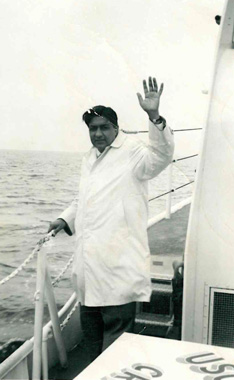
Lal Sachdeva is seen here on a U.S. coast guard boat in 1964, on his first visit to USA, prior to migrating. (Photo: courtesy of Renu and Sunil Sachdeva)
However, when Lal Sachdeva came to Atlanta in 1969, he had only himself to rely on. He did not know a single soul; all he knew was that he had been offered a job at a company called Southern Engineering. At the airport, he wasn’t sure where to go. Due to poor communication channels, he wasn’t aware of his living arrangements. With only six dollars in his pocket, Sachdeva remembers that he felt like crying, as he simply did not know what to do or where to go, at least until the next morning. “I had never felt this lost or alone in my life. Sitting at the airport, all I could think of is the relative comfort of my hometown of Gorakhpur, Uttar Pradesh.”
The loneliness was further aggravated by the displacement. Many of the first migrants came here by traveling for weeks on a ship and America was literally worlds apart. When they came, they were often disconnected from their families for weeks and months on end.
The most common form of communication was letters sent by post which would take weeks to reach their destinations in India. Long-distance calling wasn’t exactly practical during those days. At perminute rates of over $5, calling India was an expensive proposition. Even for those willing to bite the cost, the process of actually executing a call was quite long drawn. Raj Shah explains, “You had to book the call in advance, and an international operator would call you when the overseas line was available, sometimes after 24 hours!”
The impracticality of phone connectivity was further compounded by the lack of sufficient phones in rural areas in India. When Dr. K. K. and Mrs. Girija Vijay came in 1965, that was the case for Kota, the small Rajasthani town that they came from. They remember that in order to convey any urgent message to their family in Kota, they would first have to call their friend in New Delhi, who would then attempt to call Kota over a couple of days.
When not thinking of back home, there were challenges facing the pioneers here. There was often the feeling of being “a fish out of water.” Mr. Bhargave explains, “In spite of the efforts by the locals to extend to us, the fact remained that they were not accustomed to foreigners. Our ladies would be stared at for wearing sarees. Indians were new and different to them. This meant that we were always on our toes, having to explain and prove ourselves every step of the way.”
This naturally resulted in Indians gravitating towards each other, in search of solidarity and native bonhomie. By far the most striking characteristic of the early community was the immense camaraderie they felt for fellow Indians. Meeting an Indian—any Indian— in what felt, in those days, like an alien land, was a joy. The attraction to other fellow Indians triumphed over all the differences of region, religion, language, caste, or creed that would have mattered back home, because in this new country they were all from the “same place.”
According to Dr. Manocha, “There were no regional distinctions such as Gujarati or Punjabi or South Indian or Bengali. All we really saw each other as were Indians. Meeting a new Indian was such a privilege and a delight. My wife would never know whom I would be bringing home for dinner. But she was always welcoming.”
Such solidarity was alive and thriving even as late as 1977 when Raman Patel came to Atlanta. Soon after moving, Mr. Patel was hankering to make the acquaintance of another Indian soul. He looked in the Cobb county phone book for Indian last names, and stumbled upon Dr. Prakash Desai in Mableton. He coldcalled Dr. Desai and introduced himself saying that he was looking to make some Indian friends. To this, Dr. Desai replied, “I don’t make friends over phone! Come on for dinner!” Such stories abound of how the early migrants made lifelong friendships—just on the sole binding tie that they shared an Indian nationality.
A COMMUNITY TAKES ROOT
In the formative years of the early ’60s, the entire
“community” would often meet at individuals’ homes.
Manocha remembers that Jagan Bhargave and the late
Raj Chawla had a home at what used to be Williams
Street (now the downtown connector runs over it!). “It
seems like every Indian had a standing invitation to
their place.” Similarly the house of Dr. K. K. Vijay and
Mrs. Girija Vijay, next to Piedmont Park, was another
popular hangout for Indians.
As more Indians started trickling in, meetings proposing a formal organization were often held at these residences. As a result, the India Club of Georgia Tech was conceived in the late ’60s as the first informal organization representing the community. The rationale behind forming the organization around the University was twofold. A large percentage of the early Indian immigrants were students. But more importantly, aligning with the University meant being able to access many of its facilities, for meetings and special Indian movie screenings, among others.
It was not until 1971, while collecting funds for a famine in Bengal, that they were told that a registered, nonprofit status was needed to formally collect funds. This gave rise to the first formal Indian organization in Atlanta, the India American Cultural Association (IACA). That year, it had just about 100 members— which constituted practically all of the community. “Even with the small numbers, we were successful in raising thousands of dollars’ worth of cash, medicine, and other supplies to aid the victims,” declares Mr. Bhargave.
For the first few years, IACA remained as merely a fundraising organization, and only in 1975 did it first start serving as the social organization that it is now. Commenting on the contrast from then to now, Bhargave remarked that when it came to seeking office, “We were all very modest and reluctant. We had no elections, just an honorary system. People would push each other to accept the offices for IACA.”
With such being the ethos and the spirit behind the organization, it is no surprise that IACA played a crucial role in the growing community in the ’70s and ’80s. As the children of the first wave of immigrants started growing up, the elders realized the need to instil Indian culture and heritage in them. A need for a physical center—a place the community could call its own—was now acutely felt. With that goal in mind, fundraising efforts began for the purchase of an IACA building.
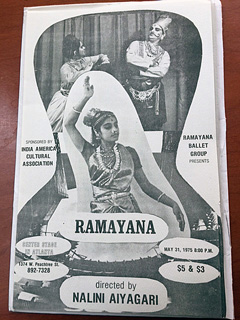
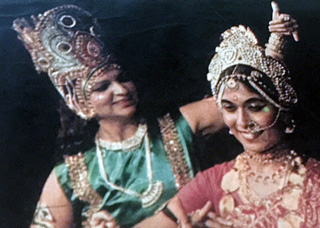
(Right) A scene from the Ramayana Ballet, featuring Vibha Desai and Usha Kadaba, and a flyer advertising it (left). Held at the Center Stage Theater in midtown, in 1975, this was the first Indian event of its size and significance. The Atlanta Journal-Constitution featured it on the cover of its Sunday magazine. (Photos: courtesy Mrs. Girija Vijay)
The Ramayana Ballet was the first such fundraising program, held at the Center Stage Theater in midtown Atlanta, in August 1975. It was primarily marketed to non-Indians. The Indian community was still too small to generate big numbers. The level of enthusiasm was such that all the participants practiced for over a year for this program! The mainstream community took note. The Atlanta Journal-Constitution, which in those days used to publish a weekly magazine supplement, featured the program on the cover of the magazine, along with a cover story titled, “Indians in Atlanta.”
The ’70s thus saw the transition of Indians from a group to what now could be called a community. The AJC article estimated a little over 1,000 Indian-Americans in the area at the time. The solidarity and singularity though, was still very much intact. Regional affiliations and organizations had still not afflicted the harmony.
With the goal of a proper facility for IACA still at hand, much remained to be done in the area of fundraising. The enterprising folks at the helm saw a distinct opportunity in the popular annual local tradition of those times—the Piedmont Arts Festival. In an otherwise conservative city, this was one festival that pulled the kind of crowd that was cosmopolitan and adventurous, and not afraid to try new experiences. “Perfect,” thought the folks at IACA, and started an Indian food booth at the Festival.
|
|
|
The IACA building, the Atlanta community’s first place to call its own as a community gathering spot.
(Photos: courtesy Mrs.
Lakshmi Rao)
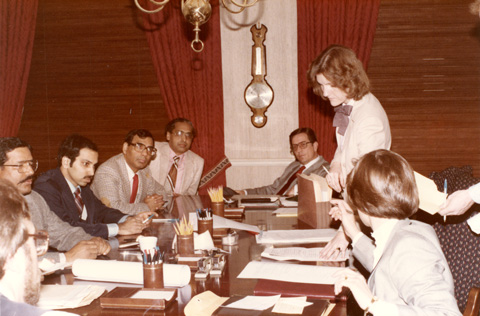
(Left) The historic moment of the closing of the purchase of the IACA building, in 1983. On the left of the table at the closing attorney’s office are Bhagirath Yadav, Lakshmi Narasimhan, Sohan Manocha, and Dr. P. Venugopal Rao. (Photo: Courtesy Mrs. Lakshmi Rao)
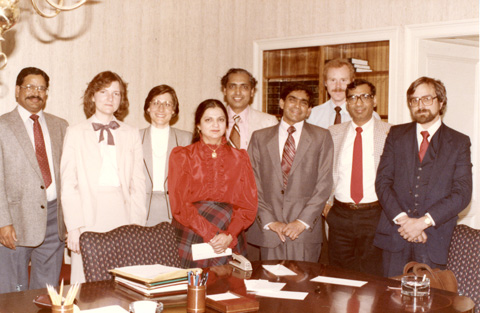
(Below) Celebratory smiles after the closing, from left: Bhagirath Yadav, Vibha Desai, P. V. Rao, Raman Patel, Sohan Manocha, along with the closing attorney Mark Weber (extreme right) and three of his staff. (Photo: Courtesy Mrs. Lakshmi Rao)
With this started an annual IACA tradition that lasted from 1978 to 1982. It was not only highly successful in raising funds, but is also fondly remembered by many who participated. This Fall festival that lasted for nine days truly brought the community together. Only three items were sold at the booth—samosas, kabobs, and mango lassi. Its popularity increased such that in 1980, the IACA booth received the “Best Food” award. The Vijay residence, which was close to Piedmont Park, would bear the brunt of the cooking. Later this ‘privilege’ went to other homes such as that of Raman Patel who was President of IACA in 1982.
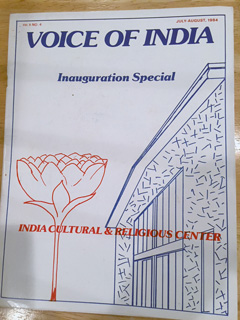
(Left) The inaugural issue of Voice of India. Edited by Dr. Uma Majmudar, it was the community’s first periodical. (Photo: courtesy Raman Patel)
At its peak, the Festival would help IACA collect close to $20,000! But more importantly, “We were having fun,” exclaimed Bhargave. “There was communal bonding; there were no conflicts.”
TURNING AMERICAN
With passing years and growing numbers, the Indians’ identification with their new home country
began to mature. The first wave of migrants slowly
but steadily gave in to America’s embrace. As their
children went to girl scouts and boy scouts, and later
to high school proms, the parents realized that they were raising American children.
For some it happened sooner than for others. The late Dr. P. V. Rao had poignantly recalled the assassination of President John F. Kennedy in 1963. “When Kennedy was shot I was still in school at Eugene, Oregon. The event shook our lives. It was not just an American tragedy. We felt it as a personal loss. After hearing the news, I came home from school only to see our little six-year-old girl crying, because in her words, ‘someone shot our President.’ At that moment we had become Americans forever.”
Regardless of when it happened, such an identity transformation, from an Indian living in America to an Indian-American was evident in many of the first wave of immigrants who now were putting down roots in the country.
As with the rest of the nation, Atlanta saw a tremendous influx of Indian immigrants in the ’80s and ’90s. Slowly, the community started changing from purely professionals to a mix of entrepreneurs, blue collar workers, and others. Indians took to small business enterprise like bees to flowers. By then, the Patels had already started carving a niche for themselves in the lodging industry.
The tech revolution that took full bloom in the 1990s further boosted the stock of Atlanta’s Indians. The young 20-something Indian professionals came, and from day one, started drawing salaries that made the whole notion of “struggling to settle down” a quaint one. The old timers who had worked for years to attain their American dream saw these young whiz kids come and buy brand new cars virtually within days of arriving.
WHERE WE ARE TODAY
The community today is indeed a far cry from the time Jagan Bhargave set foot on this land. Today, Atlanta boasts of a few dozen Indian restaurants, not to mention another dozen or so that keep
coming and going every year. These restaurants cater
to every regional bent from North Indian to South
Indian and from Gujarati to Hyderabadi, and even
Indian Chinese. Likewise, the over 100 retail stores in the metro area ensure that we can practically duplicate any Indian consumer experience from back home.
And what to say of the proliferation of regional Indian affiliations? If anything, the pet peeve of our times is that “We have way too many associations!” Today, we have Indian associations defined not only by the states that we came from, but also the language, religion, caste, subcaste, and even the house deities of our families! Regional conferences of Gujarati, Bengali, Tamil, or Telugu, for example, generate a turnout of thousands.
The early immigrants dared to leave behind the familiarity and comfort of their birthplace for a truly foreign country. Overcoming the challenges of language, culture, and in many cases, discrimination, they built lives for themselves during a very tumultuous time in America’s social history. Today, our unceasing growth along with technology and media, has helped us almost recreate a robust, successful community. The over 100,000 Indians living throughout Georgia owe a great deal to those industrious and brave individuals who laid the foundations on which our community thrives today.
The original article, previously published in Khabar in 2002, was co-authored by Mathew T. Mathews and Parthiv N. Parekh. This updated version was rewritten by Parekh.
Profiles of Pioneers
Having read about the milestones of the community in the first part of this cover feature, let’s take a closer look at the stories of some of its peoples. Thanks to the committed efforts of FRANKLIN ABBOTT, an Atlanta psychotherapist, writer, and musician, who is also a volunteer in recording oral histories in the archives at Georgia State University, we now have a source and a home for such stories—the new South Asian collection in the GSU archives. Here, Abbott talks a bit about the archives and the impetus behind it, and offers profiles of seven South Asian pioneers who are now in their retirement years. They have combined successful professional lives with civic engagement, enriching their new home country with the richness and depth of their native cultures.
|
“A purposefully envisioned and professionally curated archive is an indispensable tool for any community that takes its roots, history, and journey seriously.” |
|
– Parthiv Parekh, editorial, Khabar magazine, February 2013. |
When I read these words five years ago it rang a bell. I was deeply involved with the gift of my papers to the archives at Georgia State University and as a part of that beginning a series of oral histories with people who were important to me and to my community. I called Khabar and spoke with its editors and subsequently set up a meeting for them with the archivists at GSU. A seed was planted.
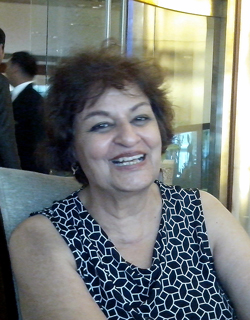
(Left) Dr. Kamla Dutt
Since then I have begun a process of interviewing some of the elders of Atlanta's South Asian Community. My initial contact was Dr. Kamla Dutt, whom I knew through Atlanta's literary scene. We are both poets. I worked with Dr. Dutt to host a reading at the Decatur Library that featured many of Atlanta's South Asian poets and writers, and met the Majmudars. It has been a privilege for me to conduct oral histories with some of Atlanta's earliest South Asian residents.
Their oral histories are now part of a new South Asian collection in the archives at GSU. Katherine Fisher is the new community collections archivist at GSU and along with Morna Gerrard, who is the head of the Women and Gender and Sexuality collections, is working to build a South Asian collection. What follows is a synopsis of seven of the oral histories. More are needed along with artifacts, publications, and photos. For more information, contact kfisher11@gsu.edu. GSU conducts workshops for those wanting to learn how to conduct oral histories.
DR. KAMLA DUTT
Dr. Kamla Dutt is a retired Professor of Pathology at Morehouse School of Medicine, a writer of two acclaimed short story collections in Hindi, and a poet in English. A veteran of the community who was one of those involved in its early institutions, she had worked with the King Center on commemorations of Gandhi’s birthday.
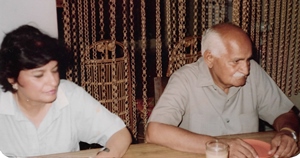
Dr. Dutt grew up in Chandigarh. Her father encouraged her to be independent and supported her in her studies of science and her love for poetry, theater, and music. Science became her priority and the focus of her career.
Having immigrated to the U.S. in 1969 as a student, she landed in Lincoln, Nebraska. “Bleak” is how she describes her year there. “I was truly a stranger in a strange land,” she adds. Things got better for her when she moved to Boston, and later to Atlanta in 1981. She found kindred spirits in these larger metros. Even as she did research in retinal cell biology at Morehouse, she managed to engage in progressive politics. During the 60’s and 70’s, she remembers, there were many excellent researchers from India in American universities who never got credit or financial reward for their work. “You were always an outsider,” she says. She found it easier in some ways to work in a minority institution like Morehouse, where she felt aligned with the school’s mission. Speaking of new immigrants like her, she observes, “Being other is their destiny with a mitigating hope that their children will do better and not be always the other.”
“Dislocation is an inherent part of creativity,” Dr. Dutt shares. Not having a sense of belonging, being in a place between the worlds of her native India, where her family still resides and where she spends time every year, and her home in Atlanta, is a part of what compels her creativity.
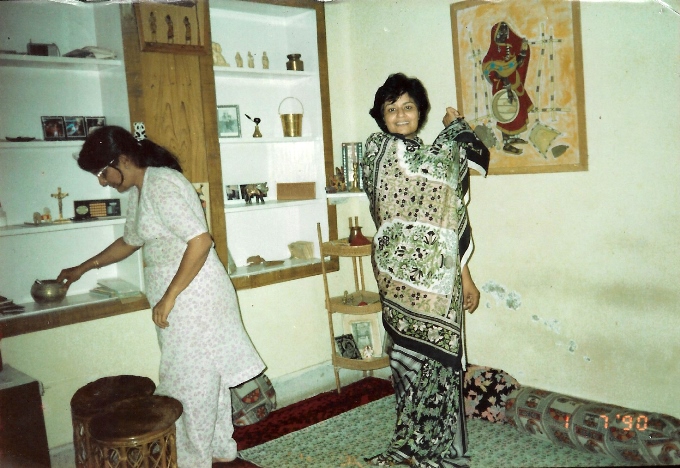
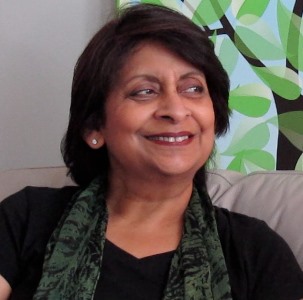
DR. SUNAINA JAIN
Much like Dr. Kamla Dutt, Dr. Sunaina Jain hails from a family with progressive values and came to the U.S. as a student at the University of Connecticut. She says, “My maternal grandfather was a pioneering journalist and idealist who, as a widower, believed he could only remarry a widow...against the religious and social rules of the times. He found and married my grandmother, eloping form the south to the north.” Her father “was a restless intellect and very curious about how people functioned. He befriended the only psychoanalyst in Delhi and began a psychotherapy practice. Otherwise he was a family doctor.” And her mother, “born to a pioneering journalist, she started off as a radio ‘voice,’ going on to become a translator, writer of radio features, and finally the editor of a series of books for children.”
Her parents encouraged her aspirations to study in the U.S., and all the arrangements for her studies had been completed when her father died suddenly. She received support from a family friend in the U.S. as well as her university, and she left India to begin a new life abroad.
What were her initial reactions to American life? “I was in awe...nothing seemed funny then. Hindsight provides a different perspective...the formality between people, taking everything too seriously...such as actually providing precise directions instead of head movements to give one directions!” But that didn’t get in the way of her education. While at school, she also met her husband. They moved to Canada and then to Atlanta, as parents of a young daughter. Dr. Jain says that by the time she had her child she was “thoroughly Americanized! Seriously, I always felt human, and raised my child to be one. Naive? Yes. Idealistic? Yes. Pragmatic? Not so sure.”
The Jains also sought out other Indians to socialize with. She shares an amusing early experience. “When we asked about the Indian community in Atlanta, one wise man said, ‘Just go to Farmer’s Market and stand in front of the coriander....you’ll meet every Indian in Atlanta!’ We’ve come a very long way from a single source for coriander/cilantro!”
Dr. Jain has had a successful career as a psychologist and a family therapist. She opened Pathways Transition Programs in 1991 and worked with clinicians to develop programs for families in distress. She continues working to train therapists to work with families and shares her “Growing Children” program for parents in seminars and webinars.
DR. PRATEEN AND VIBHA DESAI
When Dr. Prateen Desai came to the U.S. as a student, airfares were expensive, and so he came by ship. He studied mechanical engineering at Virginia Tech and later earned his Ph.D. in fluid mechanics at Tulane University. Reminiscing over his early experiences in the U.S., he says, “Life in the neighborhood didn’t much resemble the scenes of Hollywood movies seen in India.”
The Desais moved to Atlanta when he got a job teaching at Georgia Tech. They faced the struggles of a young couple, compounded by being thousands of miles from family support. While Dr. Desai was teaching and working on tenure, Mrs. Desai studied law at Emory Law School and worked on revising the 2-volume Georgia Encyclopedia of Law.
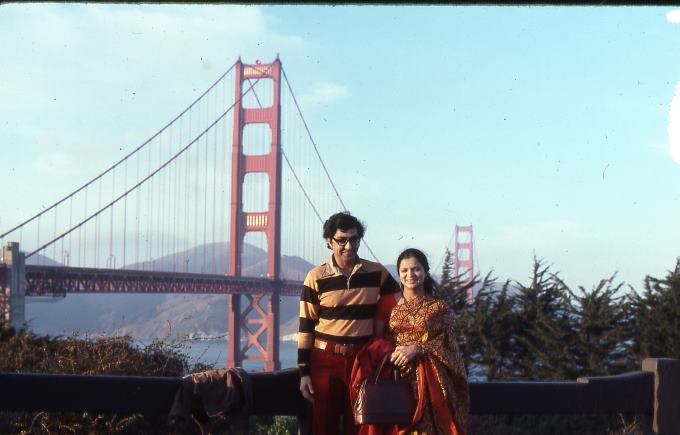
Dr. Desai says, “Our only child was raised to think and act like an American, seeking the best education and opportunities, while being advantaged by the rich Indian culture of his parents. We became full participants in the American life—the Great Book group, the Gourmet Club of Georgia Tech, Vibha as room mother at Westminster Elementary School.” Dr. and Mrs. Desai say that their ability to assimilate was due to an early resolve to find like-minded others in their university community rather than being “just clannish Indians in America.”
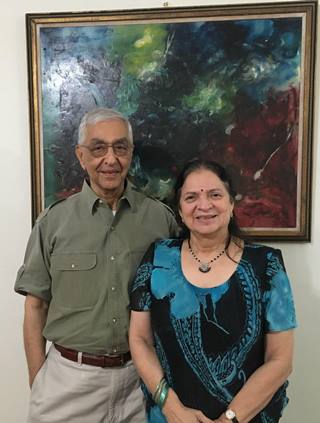
(Left) (Photo: Morna Gerrard)
Their busy careers notwithstanding, the Desais made time for participating in public life. Dr. Desai joined the civil rights movement and worked on voter registration and Andrew Young’s Congressional campaign. Vibha Desai, along with Usha Kadaba, started the first Indian dance and music academy in 1981. They began lessons in the Desai home for three students and, as their student body grew, moved classes to the new Indian cultural center, IACA, which the Desais had helped found. Students learned Indian classical dance and music and performed in many venues including King Center events, the Coca Cola centennial, and the 1988 Democratic Convention.
Before his retirement Dr. Desai taught 10,000 undergraduate students and 1,000 graduate students, supervising 18 Ph.D. dissertations. He has had teaching sabbaticals in Denmark, France, China, and Venezuela and was named National Educator of the Year in 2000 by the American Society of Engineering Education. The Desais are devoted grandparents, dividing their time between Atlanta and California where their son and his family lives.
SABIAH MUJTABA
Compared to the over two and a half million immigrants from India and their children, there are only half a million Pakistanis, 57,000 Bangladeshis, and 45,000 Sri Lankans living in the United States according to the Migration Policy Institute. These South Asian groups have many things in common and many differences. Sabiah Mujtaba was born in Pakistan but raised in the UK. She attended college there, met her husband, and her family migrated first to Panama and two years later to the USA.
Ms. Mujtaba remembers what it was like to move to Atlanta, "In the early 80s, Atlanta felt quite small to me in many ways. Having grown up in UK with the cultural diversity, I was particularly surprised at how many people didn't know where Pakistan was. India yes, so the conversations usually led to a very brief geography and history lesson.
"The challenges happened when we became green card holders and then citizens. Now we were multicultural Americans negotiating how to fit in. After some trial periods, our two sets of parents made choices to live in the States or not. I grew up in the Western culture and my parents had not created unreasonable restrictions based on religion."
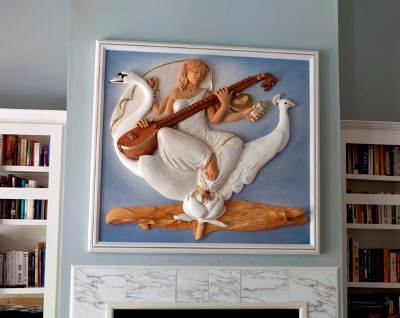
(Left) Sarasvati Devi by Sabiah Mujtaba, commissioned 2014, Atlanta, GA.
Having grown up in the UK, her perspective on raising her daughter in the USA was a little different. She says, "My daughter was just under four when we arrived. With my two nieces arriving when she was eight, and the three of them so close in their ages and very open to crosscultural experiences, their friends were of all ethnicities. As an extended family, we had no problems in associating with or moving within our adopted country. Of course, I do understand that the various cultures have created individual ethnic communities to keep their root identities and shelter themselves from dilution or absorption by the host culture. My siblings and I were brought up to 'fit in,' be open to all that was offered, and still remain with the ethical norms of our culture. I feel that in my own family that has been the case, too. We have mixed marriages with grandchildren who will continue to make America a mixed race/multicultural country."
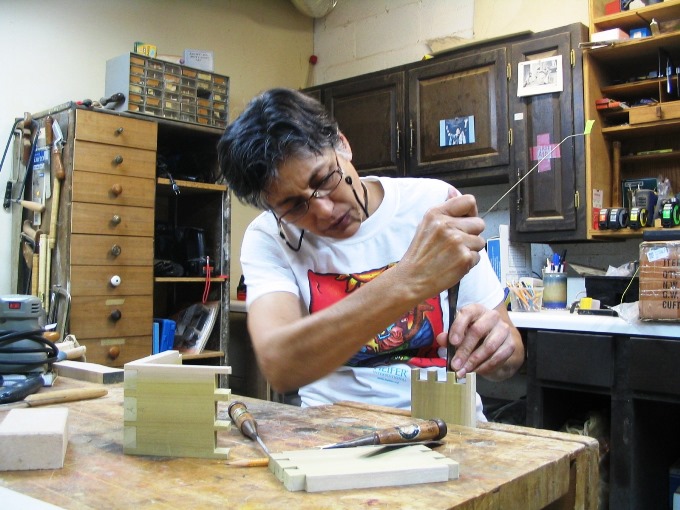
Practise of my craft, in studio, Chrysalis Woodworks, Atlanta, GA.
Ms. Mujtaba attended art school in London. It was not until later in life that she decided to make art a career. She apprenticed with Sutherland Studios and began to work with wood and furniture. In 1986 she started Chrysalis Woodworks and began accepting commissions. Her work has varied from one-of-a-kind shelves and room dividers to wooden sculpture pieces. Her most recent commissions have been for figurative carvings in a church in Knoxville, TN. She also teaches woodworking, carving, and design at Highland Woodworking in Atlanta. She remains close to her daughter and active in her family life.
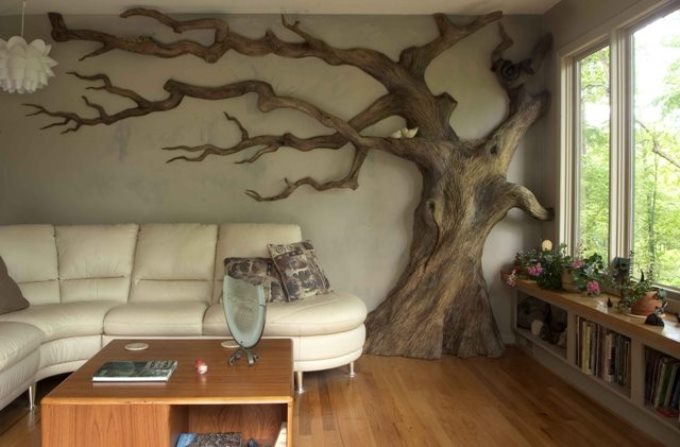
DRS. BHAGIRATH AND UMA MAJMUDAR
By profession, Dr. Bhagirath Majmudar is an Emeritus Professor of Pathology and Associate Professor of Gynecology and Obstetrics at Emory University. By passion, he is a Hindu priest who has presided over 350 marriages. Also a Sanskrit scholar, a poet, and a pillar of the community—the identities of Dr. Majmudar are many and layered.
After medical school in India, Dr. Majmudar came to the U.S. in 1966 to get a second M.D. in pathology. He taught pathology at Emory from 1971 until his retirement in 2015. Of his immigration experience, he says philosophically, “Every immigrant is bound to have strange encounters in the beginning. Only his outlook decides whether they are looked upon as ‘good’ or ‘bad.’ All my encounters have been very productive, enjoyable.”
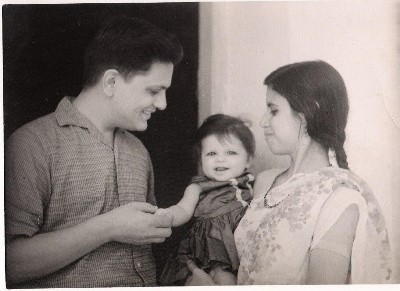
Dr. Majmudar along with his wife Dr. Uma Majmudar have remained deeply connected to their spiritual roots, much like many of the Indian community in Atlanta. He is a lifelong student of Sanskrit and has written poetry and prose in Sanskrit, Hindi, Gujarati, and English. He has conducted classes for children in Indian culture and even learned Indian classical dance in order to perform as Ravana in a much anticipated production of the Ramayana.
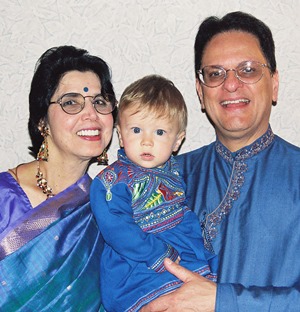
Inspired by a visit from his father, Dr. Majmudar began conducting Indian religious services. Talking about these elaborate rites and rituals, he said, “I soon delved deep into its hidden meanings, much aided by my knowledge of Sanskrit. I started conducting Hindu weddings. I felt a lot closer to Hindu and non-Hindu men and women from my college exposure so I developed my subspecialty of interfaith marriages. I have conducted over 350 marriages, mostly interfaith. It was not my profession, but a mission—to give them not just a happy wedding but a happy married life. I follow these marriages whenever possible, and most of them are doing admirably well. Nothing makes me happier!”
Dr. Majmudar has received numerous awards for teaching including the Dean’s Best Teacher Award and Emory Medical School’s highest award for teaching. He was chosen for the World Health Organization (WHO) Geneva’s Team for Reproductive Biology.
Dr. Uma Majmudar had worked as a drama artiste and stage performer in India for All India Radio. Daughter of a lawyer who practiced as a public prosecutor in Ahmedabad, she imbibed an appreciation for books and literature from her father. She earned her doctorate from Emory University in 1996. The topic of her dissertation was “Mahatma Gandhi’s Trajectory of Truth and Fowler’s Theory of Stages of Faith.” She has taught at Emory, and in the Religion and Philosophy Department at Spelman College, where she offered a course on the Bhagavad Gita last Spring.
She says she had many surprises when she moved to America. “The first one happened on the very first day of our coming to America, on one summery but not scorching day (by Indian standards) in July 1967. My physician husband and I with our then 2-year-old daughter, landed at the Boston airport to be greeted by his would-be employer—a doctor—at the Salem Hospital in Salem, Massachusetts. In a huge station wagon (later we found out that he was a Catholic and had seven kids), he was driving us to his home in Salem about an hour’s ride from the airport. As the car entered his driveway, I almost had an “eye-attack!” The two teenage daughters of our host were sitting right in the middle of their driveway, wearing sleeveless shirts and “short shorts,” which were also torn at places! My head started reeling, trying to figure out why they were dressed in such torn and tattered clothes which were fit only for beggars in India! Now that I have gone through raising my own teenage daughters in America, I have come to accept, or rather tolerate, that torn jeans or short shorts are a fashion statement for the young. Still, to my then virgin Indian eyes, that first exposure to the American way of dressing was not only funny, but also quite embarrassing. Thank God, I said to myself, they were not sitting there in string bikinis! Oh, then perhaps, I’d really have had a heart attack!”
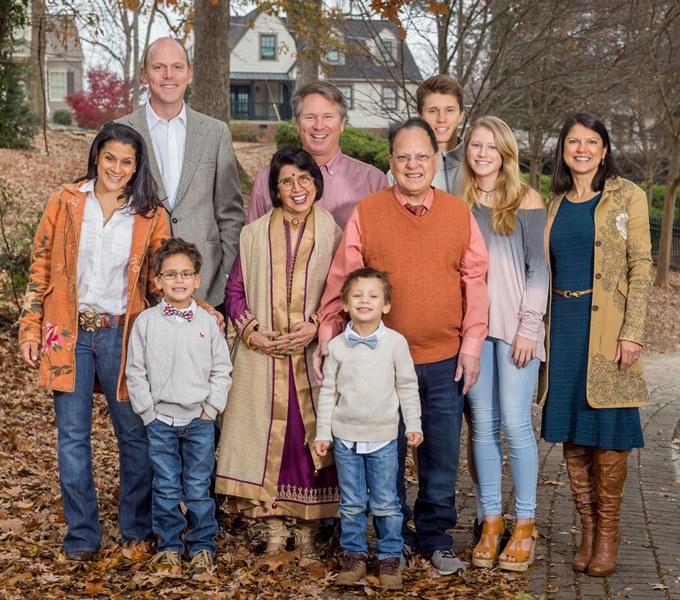
“No other topic occupied my mind as much and as seriously as this: how to bring up our two daughters to make them feel at home both in America and India, their inherited ancestral home!” exclaims Dr. Uma Majmudar. They invested in preparing them positively for a bilingual, bicultural, and bireligious life here. At home we tried to create an environment in which both cultures breathed freely. American friends of our children were as welcome at our home as Indian, and so also were the foods, languages, and celebrations of different religious holidays. Each culture has its shortcomings and each has positive aspects. Our goal was to make them aware of both and then trust their judgment to make the right choice without being judgmental as parents. Looking at the results today, we feel deeply satisfied, if not also proud of the way they turned out. It fills our hearts with unspeakable joy and gratitude to see our grown daughters teach their children the same Sanskrit shlokas, recite prayers, read and tell them such stories as “Bhakta Prahlad” or “Bal Krishna, the Butter Thief”!
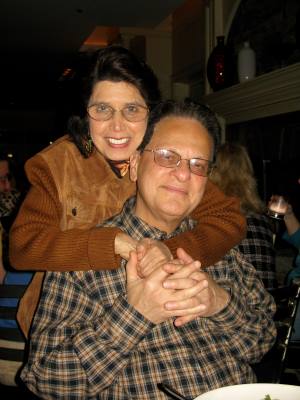
Dr. Uma Majmudar, in addition to parenting, graduate studies, and teaching was very active in the early years of the Indian community’s cultural development. In 1976 she founded and edited The Voice of India, a quarterly newsletter of the India American Cultural Association (IACA). She wrote a plethora of articles for The Atlanta Journal and Constitution, American Vedantist, India Abroad, India West, India Journal, and Khabar.
She is author of Gandhi’s Pilgrimage of Faith: From Darkness to Light published by the State University of New York Press in 2005 and is working on a second book for the same press entitled Mahatma-to-be and Mahatma-maker: Gandhi and Rajachandra. She and her husband Dr. Bhagirath Majmudar remain active in Atlanta’s Indian community and are devoted grandparents.
In thinking about being both Indian and American, Dr. Uma Majmudar quotes Gandhiji,
"I do not want my house to be walled in on all sides and my windows to be stuffed. I want the cultures of all the lands to be blown about my house as freely as possible, but I refuse to be blown off my feet by any."
In his new book The Other One Percent : Indians in America (Oxford University Press, 2017), Professor Devesh Kapur talks about the amazing success of Indian immigration to the USA. Immigrant Indians and their children now make up more than 1 percent of the U.S. population. They are the most educated and economically successful group in the country. Our subjects were all part of the first wave of Indian immigration that came in the wake of the Immigration and Nationality Act of 1965, which changed the rules of immigration to favor skills and families. Most of this group were well educated doctors and scientists. The next wave to follow was of their family members. About two-thirds of India-born Americans came in the third wave. Dr. Kapur calls them "the IT generation." Their world is very different from that of the first generation who paved the way for all who followed.
Each of the individuals interviewed for this article came to the USA at a time when very few South Asians did. They were all young, beginning careers, raising families, and looking out for each other. Jhumpa Lahiri in her story "When Mr. Pirzada Came to Dine" talks about an Indian couple in the first wave of immigration who were part of an academic community. Every year they would scan the faculty register for names they were familiar with, names from the part of the world they came from, and reach out to the newcomers in search of a sense of community. Our subjects in this article did more than just reach out. Together they forged a vital community with formal institutions and informal links. Between them they have taught thousands of students, written books, done substantive research, created art and poetry. They have fostered traditions from home in a new world, giving the young people of their community access to language, music, and spirituality from their country of origin. They have made their new country better than they found it. Their contributions are undeniable and of great value. They are only a few of their generation whose stories need to be preserved. Courage and creativity are among the many gifts of their celebrated lives.
Website Bonus Feature
Link:
"Indian Classical Dance & Music Over The Years"
BY DR. SESHU SARMA
http://www.nripulse.com/CityNews/Indian_Classical_Scene.html
Enjoyed reading Khabar magazine? Subscribe to Khabar and get a full digital copy of this Indian-American community magazine.
blog comments powered by Disqus



